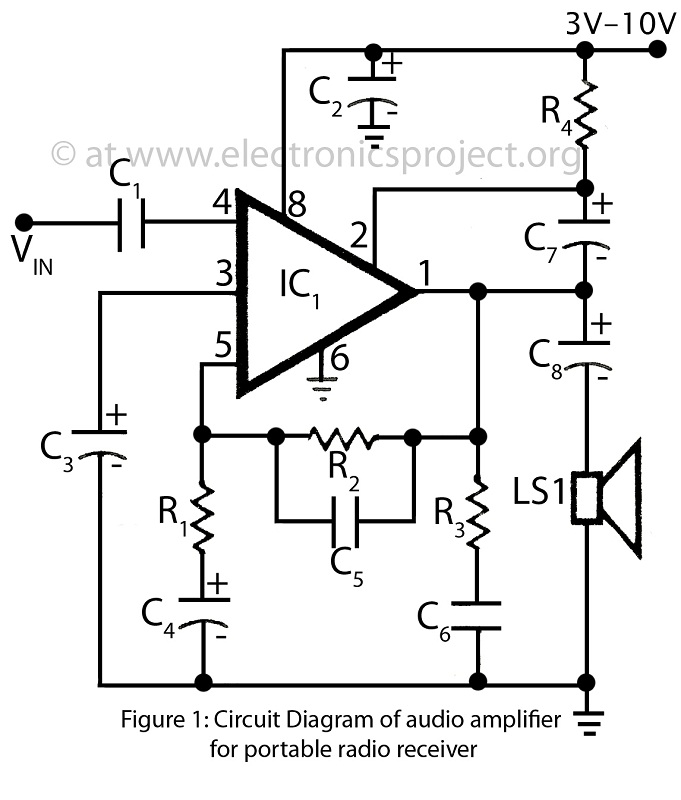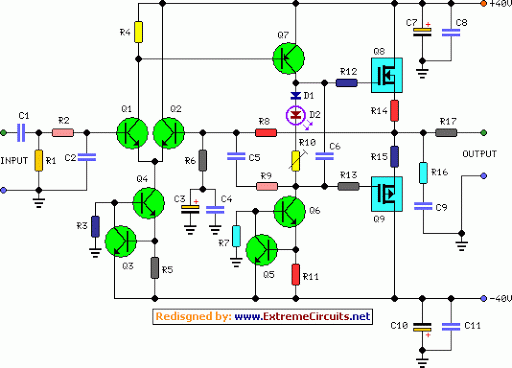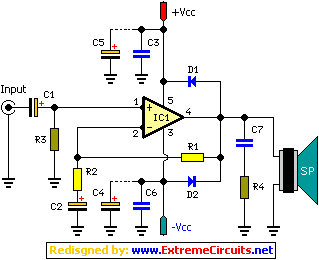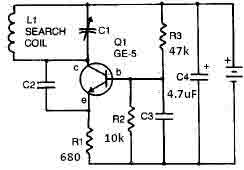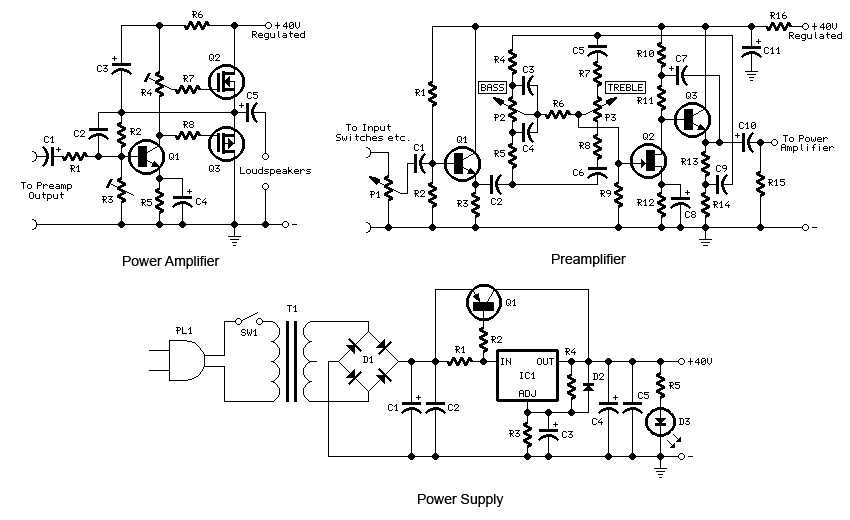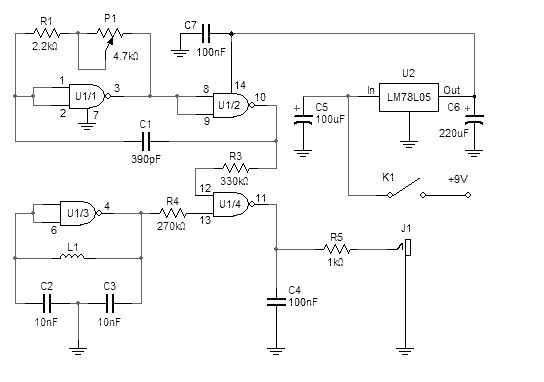
audio peak detector
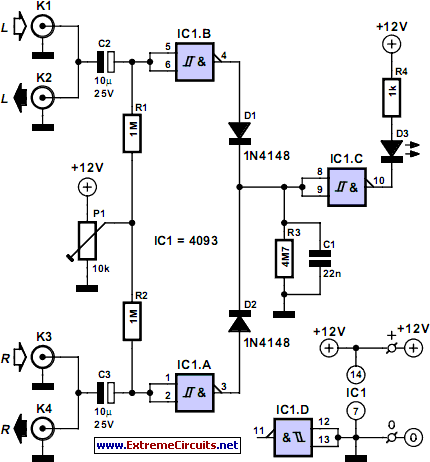
This audio peak detector enables monitoring of a pair of stereo channels using a single LED indicator. The circuit employs identical configurations for both left and right channels. It utilizes the switching levels of Schmitt trigger NAND gates within the well-known 4093 integrated circuit. The threshold level for gate IC1.A (IC1.B) is established using a preset resistor P1, which provides a high impedance bias level through resistors R2 (R1). When the instantaneous level of the audio signal, combined with the bias voltage from capacitors C3 (C2), causes the DC level at pins 1 and 2 (5 and 6) of the Schmitt trigger gate to fall below a specified threshold, the output of IC1.A (IC1.B) transitions to a high state. This output is then transferred to the input of IC1.C via diodes D2 (D1), and due to the inverting behavior of IC1.C, LED D3 illuminates. The combination of resistor R3 and capacitor C1 introduces a delay, ensuring that very brief audio peaks can be accurately indicated. Initially, the wiper of P1 should be turned to the +12 V position, ensuring that LED D3 remains off. Line-level audio should then be applied to connectors K1 and K3, ideally using music with pronounced peaks (such as drum and bass). The adjustment of P1 should be done carefully to ensure that the peaks of the audio signal are effectively indicated by LED D3. The circuit features dual RCA connectors for the left and right channels, eliminating the need for costly audio splitter cables.
This audio peak detector circuit is designed to visually indicate audio signal peaks from stereo channels using a single LED. The core of the circuit is based on the 4093 IC, which contains multiple Schmitt trigger NAND gates. Each channel's signal is processed identically, ensuring consistent performance.
The threshold for detecting peaks is adjustable via the preset resistor P1. This allows for calibration based on the specific audio signal characteristics, accommodating different audio sources and levels. The high impedance bias provided by R2 (R1) allows for the audio signal to be superimposed effectively, ensuring that the Schmitt trigger gates respond appropriately to changes in the audio signal.
When the audio signal, combined with the bias voltage, causes the voltage at the input pins of the Schmitt trigger to drop below the defined threshold, the output transitions to a high state. This transition is crucial as it triggers the subsequent stages of the circuit. The output from IC1.A (IC1.B) is fed into IC1.C, which inverts the signal, thereby lighting LED D3 when a peak is detected.
The inclusion of R3 and C1 introduces a delay in the circuit, which is essential for accurately capturing short audio peaks. This delay prevents the LED from flickering due to rapid fluctuations in the audio signal, allowing for a more stable visual indication of audio peaks.
The circuit is designed for ease of use, with initial setup instructions that guide the user to adjust the threshold to ensure proper operation. By applying line-level audio to the RCA connectors, users can effectively monitor audio signals without the need for specialized splitter cables, making this circuit a practical solution for audio peak detection in various applications.This audio peak detector allows a pair of stereo channels to be monitored on a single LED. Identical circuitry is used in the left and right channels. Use is made of the switching levels of Schmitt trigger NAND gates inside the familiar 4093 IC. The threshold level for gate IC1. A (IC1. B) is set with the aid of preset P1, which supplies a high impe dance bias level via R2 (R1). When, owing to the instantaneous level of the audio signal superimposed on the bias voltage by C3 (C2), the dc level at pins 1 and 2 (5 and 6) of the Schmitt trigger gate drops below a certain level, the output of IC1. A (IC1. B) will go High. This level is copied to the input of IC1. C via D2 (D1) and due to the inverting action of IC1. C, LED D3 will light. Network R3-C1 provides some delay to enable very short audio peaks to be reliably indicated. Initially turn the wiper of P1 to the +12 V extreme ” LED D3 should remain out. Then apply line` level audio to K1 and K3, preferably music with lots of peaks (for example, drum n bass).
Carefully adjust P1 until the peaks in the music are indicated by D3. The circuit has double RCA connectors for the left and right channels to obviate the use of those rare and expensive audio splitter (Y`) cables. 🔗 External reference
This audio peak detector circuit is designed to visually indicate audio signal peaks from stereo channels using a single LED. The core of the circuit is based on the 4093 IC, which contains multiple Schmitt trigger NAND gates. Each channel's signal is processed identically, ensuring consistent performance.
The threshold for detecting peaks is adjustable via the preset resistor P1. This allows for calibration based on the specific audio signal characteristics, accommodating different audio sources and levels. The high impedance bias provided by R2 (R1) allows for the audio signal to be superimposed effectively, ensuring that the Schmitt trigger gates respond appropriately to changes in the audio signal.
When the audio signal, combined with the bias voltage, causes the voltage at the input pins of the Schmitt trigger to drop below the defined threshold, the output transitions to a high state. This transition is crucial as it triggers the subsequent stages of the circuit. The output from IC1.A (IC1.B) is fed into IC1.C, which inverts the signal, thereby lighting LED D3 when a peak is detected.
The inclusion of R3 and C1 introduces a delay in the circuit, which is essential for accurately capturing short audio peaks. This delay prevents the LED from flickering due to rapid fluctuations in the audio signal, allowing for a more stable visual indication of audio peaks.
The circuit is designed for ease of use, with initial setup instructions that guide the user to adjust the threshold to ensure proper operation. By applying line-level audio to the RCA connectors, users can effectively monitor audio signals without the need for specialized splitter cables, making this circuit a practical solution for audio peak detection in various applications.This audio peak detector allows a pair of stereo channels to be monitored on a single LED. Identical circuitry is used in the left and right channels. Use is made of the switching levels of Schmitt trigger NAND gates inside the familiar 4093 IC. The threshold level for gate IC1. A (IC1. B) is set with the aid of preset P1, which supplies a high impe dance bias level via R2 (R1). When, owing to the instantaneous level of the audio signal superimposed on the bias voltage by C3 (C2), the dc level at pins 1 and 2 (5 and 6) of the Schmitt trigger gate drops below a certain level, the output of IC1. A (IC1. B) will go High. This level is copied to the input of IC1. C via D2 (D1) and due to the inverting action of IC1. C, LED D3 will light. Network R3-C1 provides some delay to enable very short audio peaks to be reliably indicated. Initially turn the wiper of P1 to the +12 V extreme ” LED D3 should remain out. Then apply line` level audio to K1 and K3, preferably music with lots of peaks (for example, drum n bass).
Carefully adjust P1 until the peaks in the music are indicated by D3. The circuit has double RCA connectors for the left and right channels to obviate the use of those rare and expensive audio splitter (Y`) cables. 🔗 External reference
